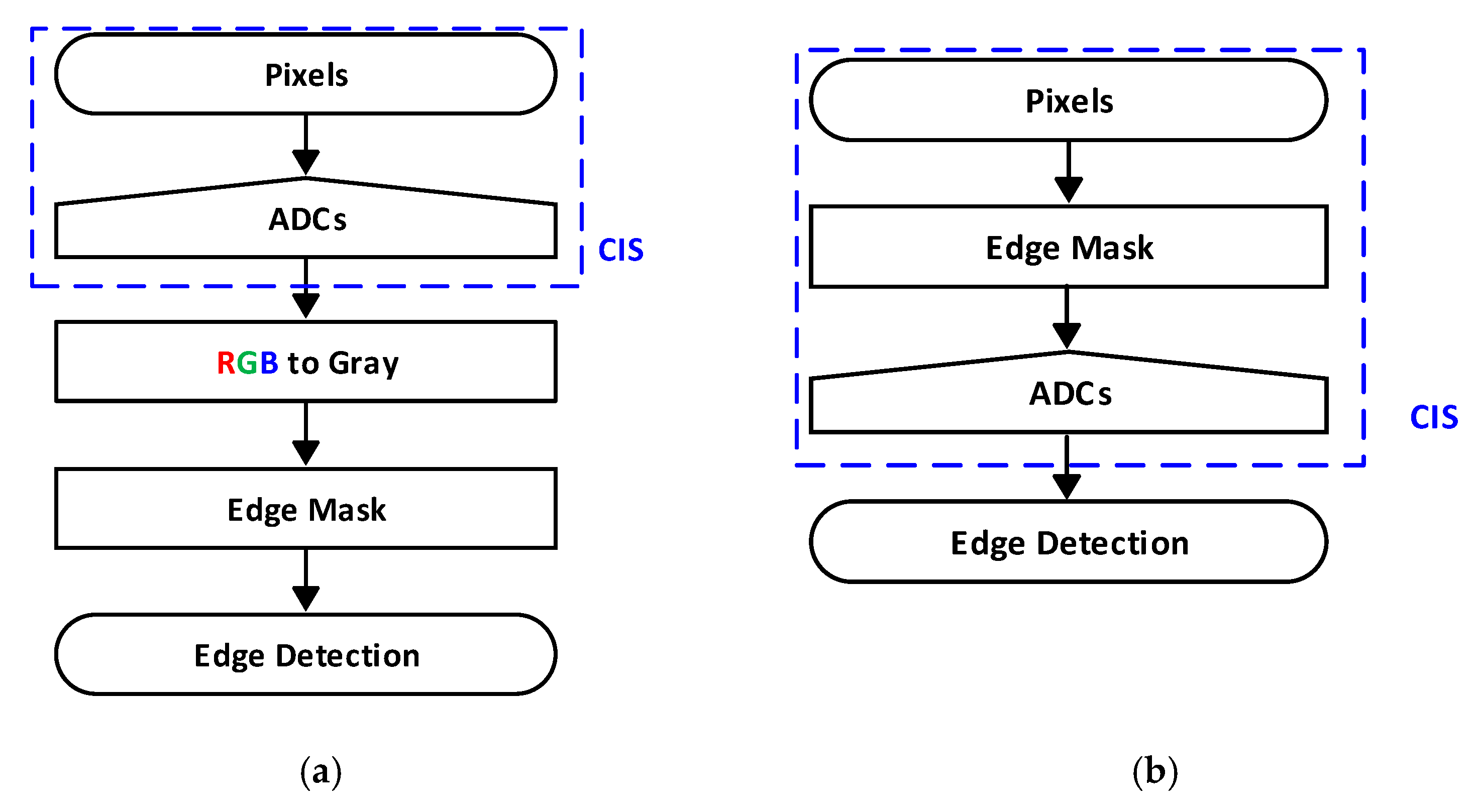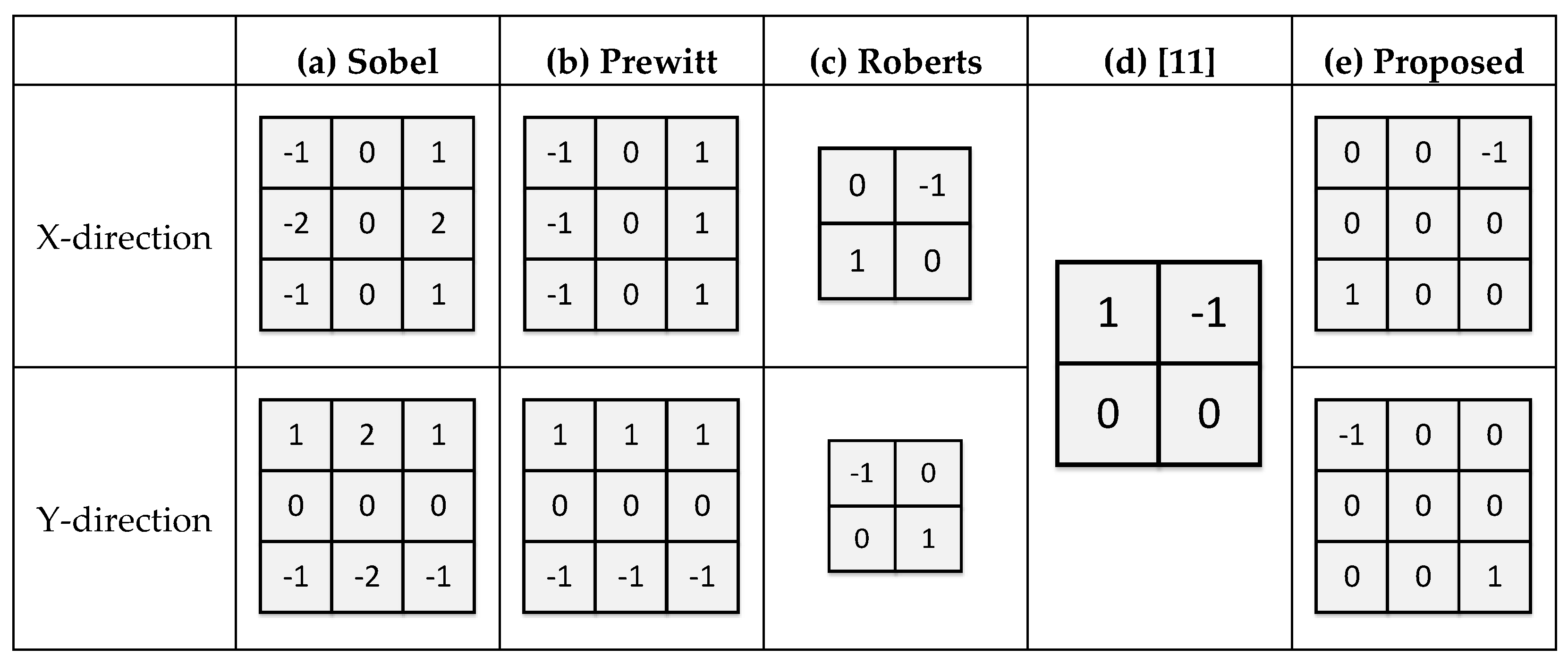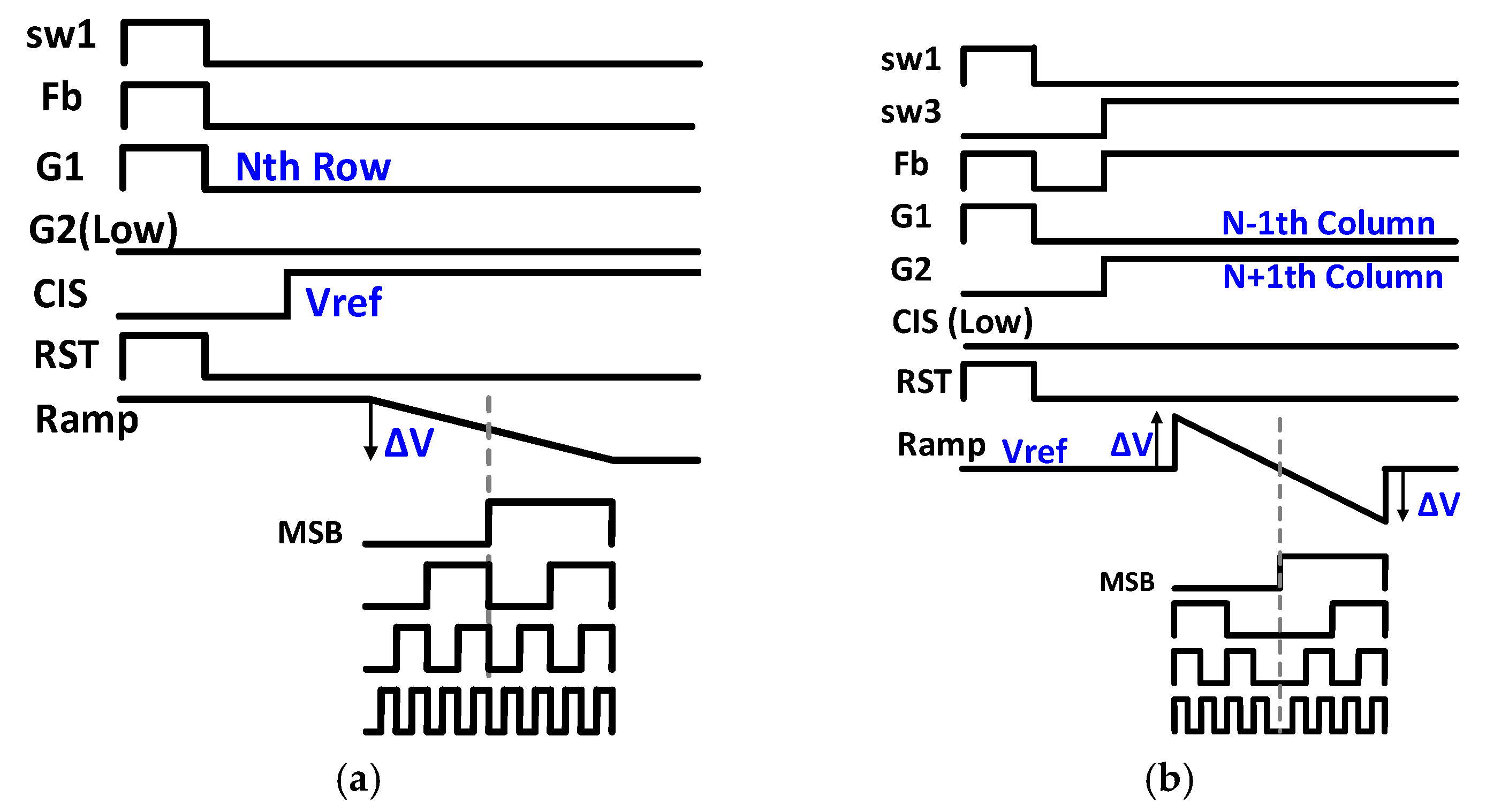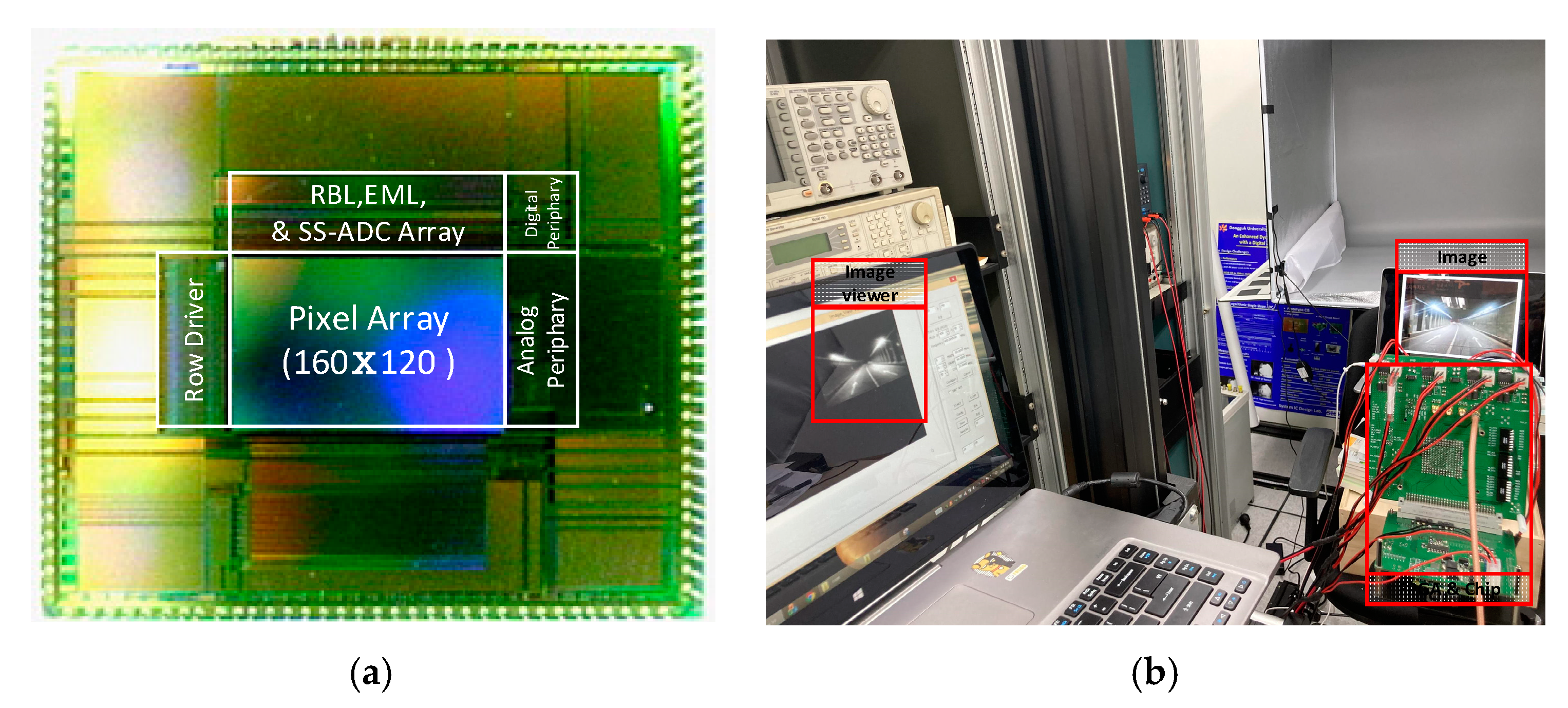On-CMOS Image Sensor Processing for Lane Detection
Abstract
:1. Introduction
2. Proposed CIS Structure
2.1. Conventional Edge Detection Mask Algorithm
2.2. Proposed Edge Detection Algorithm
2.3. Operation of the Proposed CIS with the Built-In Mask
3. Experimental Results
3.1. Chip Photograph and Measurement Environment
3.2. Measurement Results
4. Conclusions
Author Contributions
Funding
Institutional Review Board Statement
Informed Consent Statement
Data Availability Statement
Acknowledgments
Conflicts of Interest
References
- Vinuchandran, A.V.; Shanmughasundaram, R. A real-time lane departure warning and vehicle detection system using monoscopic camera. In Proceedings of the 2017 International Conference on Intelligent Computing, Instrumentation and Control Technologies (ICICICT), Kannur, India, 6–7 July 2017; pp. 1565–1569. [Google Scholar]
- Lan, M.; Rofouei, M.; Soatto, S.; Sarrafzadeh, M. SmartLDWS: A robust and scalable lane departure warning system for the smartphones. In Proceedings of the 2009 12th International IEEE Conference on Intelligent Transportation Systems, St. Louis, MI, USA, 4–7 October 2009; pp. 1–6. [Google Scholar]
- Shu, Y.; Tan, Z. Vision based lane detection in autonomous vehicle. In Proceedings of the Fifth World Congress on Intelligent Control and Automation (IEEE Cat. No.04EX788), Hangzhou, China, 15–19 June 2004; Volume 6, pp. 5258–5260. [Google Scholar]
- Qu, C.; Bi, D.-Y.; Sui, P.; Chao, A.-N.; Wang, Y.-F. Robust Dehaze Algorithm for Degraded Image of CMOS Image Sensors. Sensors 2017, 17, 2175. [Google Scholar] [CrossRef] [PubMed] [Green Version]
- Cayula, J.; Cornillon, P. Edge Detection Algorithm for SST Images. J. Atmosp. Ocean. Technol. 1992, 9, 67–80. [Google Scholar] [CrossRef]
- Tang, S.J.W.; Ng, K.Y.; Khoo, B.H.; Parkkinen, J. Real-Time Lane Detection and Rear-End Collision Warning System on a Mobile Computing Platform. In Proceedings of the 2015 IEEE 39th Annual Computer Software and Applications Conference, Taichung, Taiwan, 1–5 July 2015; pp. 563–568. [Google Scholar]
- Hwang, S.; Lee, Y. FPGA-based real-time lane detection for advanced driver assistance systems. In Proceedings of the 2016 IEEE Asia Pacific Conference on Circuits and Systems (APCCAS), Jeju, Korea, 25–28 October 2016; pp. 218–219. [Google Scholar]
- Takahashi, N.; Shibata, T. A row-parallel cyclic-line-access edge detection CMOS image sensor employing global thresholding operation. In Proceedings of the 2010 IEEE International Symposium on Circuits and Systems, Paris, France, 30 May–2 June 2010; pp. 625–628. [Google Scholar]
- Lee, C.; Chao, W.; Lee, S.; Hone, J.; Molnar, A.; Hong, S.H. A Low-Power Edge Detection Image Sensor Based on Parallel Digital Pulse Computation. IEEE Trans. Circuits Syst. II Express Briefs 2015, 62, 1043–1047. [Google Scholar] [CrossRef]
- Chaple, G.N.; Daruwala, R.D.; Gofane, M.S. Comparisons of Robert, Prewitt, Sobel operator based edge detection methods for real time uses on FPGA. In Proceedings of the 2015 International Conference on Technologies for Sustainable Development (ICTSD), Mumbai, India, 4–6 February 2015; pp. 1–4. [Google Scholar] [CrossRef]
- Jin, M.; Noh, H.; Song, M.; Kim, S.Y. Design of an Edge-Detection CMOS Image Sensor with Built-in Mask Circuits. Sensors 2020, 20, 3649. [Google Scholar] [CrossRef] [PubMed]
- Pande, S.; Bhadouria, V.S.; Ghoshal, D. A Study on Edge Marking Scheme of Various Standard Edge Detectors. Int. J. Comput. Appl. 2012, 44, 33–37. [Google Scholar] [CrossRef]
- Abdou, I.E.; Pratt, W.K. Quantitative design and evaluation of enhancement/thresholding edge detectors. Proc. IEEE 1979, 67, 753–763. [Google Scholar] [CrossRef]
- Biswas, R.; Sil, J. An Improved Canny Edge Detection Algorithm Based on Type-2 Fuzzy Sets. Procedia Technol. 2012, 4, 820–824. [Google Scholar] [CrossRef] [Green Version]
- Young, C.; Omid-Zohoor, A.; Lajevardi, P.; Murmann, B. 5.3 A Data-Compressive 1.5b/2.75b Log-Gradient QVGA Image Sensor with Multi-Scale Readout for Always-On Object Detection. In Proceedings of the 2019 IEEE International Solid-State Circuits Conference—(ISSCC), San Francisco, CA, USA, 17–21 February 2019; pp. 98–100. [Google Scholar]











| PFOM (%) | Sobel | Prewitt | Roberts | [11] | Proposed (3 × 3) |
|---|---|---|---|---|---|
| Sobel (ref) | 100 | 99.75 | 97.44 | 95.38 | 98.89 |
| PFOM (%) | (c) | (d) | (e) | (f) |
|---|---|---|---|---|
| Sobel (Ref) | 97.44 | 98.89 | 96.32 | 92.54 |
| (1) Sobel | (2) Prewitt | (3) Roberts | (4) Column-Comparing | (5) Proposed Mask | (6) Proposed Edge Detection CIS | |||||||
|---|---|---|---|---|---|---|---|---|---|---|---|---|
| Top 8 | Top 9 | Top 8 | Top 9 | Top 8 | Top 9 | Top 8 | Top 9 | Top 8 | Top 9 | Top 8 | Top 9 | |
| Line | 4 | 4 | 3 | 4 | 3 | 4 | 3 | 3 | 4 | 4 | 4 | 4 |
| Noise | 1 | 1 | 0 | 1 | 0 | 1 | 1 | 1 | 1 | 1 | 1 | 1 |
| PFOM (%) | Sobel (Ref) | Prewitt | Roberts | [11] | Proposed Mask |
|---|---|---|---|---|---|
| Pre | 100 | 99.75 | 97.44 | 95.38 | 98.89 |
| Post | 100 | 98 | 94.95 | 90.51 | 97.24 |
| Δ | - | 1.75 | 2.49 | 4.87 | 1.65 |
| Technology | 110 nm 1P4M CIS Process |
|---|---|
| Pixel array | 160 120 |
| Pixel size () | 12.8 12.8 |
| ADC resolution (bit) | 8 |
| Power consumption (mW) | 9.4 |
| Max. frame rate (fps) | 145 in CIS mode |
| 113 in edge detection mode | |
| Chip size () | 5900 5240 |
| Supply voltage (V) | 3.3 (analog/pixel) |
| 1.5 (digital) |
| [8] | [9] | [11] | This Work | |
|---|---|---|---|---|
| Edge Image |  |  |  |  |
| Process | 180 nm 1P 5M CMOS | 180 nm 1P 4M CIS | 90 nm 1P 5M CIS | 110 nm 1P 4M CIS |
| Resolution | 70 68 | 105 92 | 1920 1440 | 160 120 |
| Pixel pitch (μm) | 25.7 | 8 | 1.4 | 12.8 |
| Supply voltage (V) | 1.8 | 1.6 | 3.3 | 3.3 |
| Frame/s | 28 | 30 | 60 | 113 (edge) 145 (CIS) |
| Power consumption | 110 mW | 8 mW | 9.4 mW (60 fps) | 9.4 mW (145 fps) |
Publisher’s Note: MDPI stays neutral with regard to jurisdictional claims in published maps and institutional affiliations. |
© 2021 by the authors. Licensee MDPI, Basel, Switzerland. This article is an open access article distributed under the terms and conditions of the Creative Commons Attribution (CC BY) license (https://creativecommons.org/licenses/by/4.0/).
Share and Cite
Lee, S.; Jeong, B.; Park, K.; Song, M.; Kim, S.Y. On-CMOS Image Sensor Processing for Lane Detection. Sensors 2021, 21, 3713. https://doi.org/10.3390/s21113713
Lee S, Jeong B, Park K, Song M, Kim SY. On-CMOS Image Sensor Processing for Lane Detection. Sensors. 2021; 21(11):3713. https://doi.org/10.3390/s21113713
Chicago/Turabian StyleLee, Soyeon, Bohyeok Jeong, Keunyeol Park, Minkyu Song, and Soo Youn Kim. 2021. "On-CMOS Image Sensor Processing for Lane Detection" Sensors 21, no. 11: 3713. https://doi.org/10.3390/s21113713
APA StyleLee, S., Jeong, B., Park, K., Song, M., & Kim, S. Y. (2021). On-CMOS Image Sensor Processing for Lane Detection. Sensors, 21(11), 3713. https://doi.org/10.3390/s21113713







